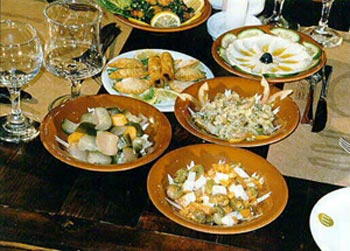| Home / International / International -- Cultural Sidelines | Tools: Save | Print | E-mail | Most Read |
| Hunger for the West |
| Adjust font size: |
For decades, Chinese cuisine has been making a journey to the West. But today, the dinner tables are turning.
A recent food and hospitality tradeshow in "You can see the foreign food shelves in Chinese grocery stores are getting bigger and bigger," said Brendan Jennings, general manager of China International Exhibitions Ltd and organizer of the tradeshow, FHC Beijing 2007. The event attracted more than 100 companies from 19 countries from June 13 to 15 at the While organizers don't purposefully exclude Chinese food, "99 percent" of the exhibitors dealt in imports, "I'm looking to do some Japanese or Italian fusion," he said. "I do Chinese food now, but I'd like to add some ingredients from other countries. This seemed like a good place to get new ideas." "What they (restaurant owners) are finding out is that the younger Chinese are adventurous, and they're not afraid to ask," According to Milan Gold Coffee Co Ltd general manager Zhou Xuesong, this unabashed curiosity has led to the development of a more sophisticated coffee culture among Chinese. "Before, people would think coffee was Nestle," Zhou said. "But now, they ask more sophisticated questions and have a more sophisticated idea about coffee. When they go to a restaurant now, sometimes they ask for an espresso; sometimes they ask for a cappuccino; sometimes they ask for a latte." Like Starbucks and many other coffee providers in "Coffee is still a new thing in CIE Communications manager Susan Tan said a unique feature of the show was its country pavilions, which introduced goods most Chinese wouldn't associate with those national cuisines. "In a lot of countries, a lot of people would be familiar with American and Australian wine, but not so many would be familiar with Greek wine," Tan says. "They might have heard of it but haven't tried it." Iliana Sidiroppouou, enologist of the Interprofessional Organization of Vine and Wine of Greece, said the exhibition provided a great opportunity to introduce Chinese drinkers to Greek wines, which are little known despite the country's unique indigenous grape varieties. She said that the Wonderful Wines campaign of the European Union and "Chinese people know about She added that about 100 people had visited their booth within the first two hours of the exhibition, but it seemed "they didn't know exactly what they were looking for". Like the Greek pavilion, the Spanish pavilion also sought to introduce foods that most Chinese wouldn't associate with the country. In addition to the expected olive oil and wine, the pavilion's display shelves were crowded with Spanish chocolate, spices and jams. Head of the Spanish embassy's Agriculture, Foods and Beverages Department Cristina Mari Torres said that while olive oil - the primary foodstuff Chinese associate with "People might know about olive oil, but they might think it's a Western food. Cooking with olive oil is something they might not think of doing," Torres said. As "The Chinese are getting acclimated to these particular styles and tastes, then, they'll start to differentiate preferences - 'I like this brand better than that brand'," "Most of the companies that come to But while the market still has a long road ahead to maturity, "When we first did a show in "In 1994, it was 100 percent restaurants. Last year, it was nicely split between 30 percent hospitality, 30 percent retailers and 30 percent importer-traders." He said that in 1994, import barriers were the main obstacles to Chinese people developing tastes for foreign foods. Then, there were only a handful of government departments that could approve import licenses, and importers had no choice but to go through them. "They (the companies) would look at this stuff and say: 'We'd love to import it, but we can't'." But with the government's liberalization and "As the amount of imported food grows, so does demand for that food," he said. And today's growing supply of imported victuals is now feeding the hunger of a growing group of modern Chinese. ( |
| Tools: Save | Print | E-mail | Most Read |
 |
| Related Stories |
| Chinese Imperial Cuisine |
| Chinese Cuisines Recommended for Olympic Menu |
| Creative Cantonese Cuisine at China Spice |
| Royal Cuisine Restaurant Celebrates 80th Birthday |
 |
 |
|
 |
| Links |
